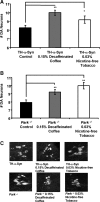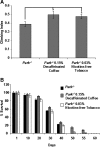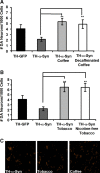Decaffeinated coffee and nicotine-free tobacco provide neuroprotection in Drosophila models of Parkinson's disease through an NRF2-dependent mechanism
- PMID: 20410106
- PMCID: PMC3842467
- DOI: 10.1523/JNEUROSCI.4777-09.2010
Decaffeinated coffee and nicotine-free tobacco provide neuroprotection in Drosophila models of Parkinson's disease through an NRF2-dependent mechanism
Abstract
Epidemiological studies have revealed a significantly reduced risk of Parkinson's disease (PD) among coffee and tobacco users, although it is unclear whether these correlations reflect neuroprotective/symptomatic effects of these agents or preexisting differences in the brains of tobacco and coffee users. Here, we report that coffee and tobacco, but not caffeine or nicotine, are neuroprotective in fly PD models. We further report that decaffeinated coffee and nicotine-free tobacco are as neuroprotective as their caffeine and nicotine-containing counterparts and that the neuroprotective effects of decaffeinated coffee and nicotine-free tobacco are also evident in Drosophila models of Alzheimer's disease and polyglutamine disease. Finally, we report that the neuroprotective effects of decaffeinated coffee and nicotine-free tobacco require the cytoprotective transcription factor Nrf2 and that a known Nrf2 activator in coffee, cafestol, is also able to confer neuroprotection in our fly models of PD. Our findings indicate that coffee and tobacco contain Nrf2-activating compounds that may account for the reduced risk of PD among coffee and tobacco users. These compounds represent attractive candidates for therapeutic intervention in PD and perhaps other neurodegenerative diseases.
Figures








Similar articles
-
Current evidence for neuroprotective effects of nicotine and caffeine against Parkinson's disease.Drugs Aging. 2001;18(11):797-806. doi: 10.2165/00002512-200118110-00001. Drugs Aging. 2001. PMID: 11772120 Review.
-
Smoking, coffee intake, and Parkinson's disease: Potential protective mechanisms and components.Neurotoxicology. 2025 Jan;106:48-63. doi: 10.1016/j.neuro.2024.12.003. Epub 2024 Dec 17. Neurotoxicology. 2025. PMID: 39701424 Review.
-
Quercetin, not caffeine, is a major neuroprotective component in coffee.Neurobiol Aging. 2016 Oct;46:113-23. doi: 10.1016/j.neurobiolaging.2016.06.015. Epub 2016 Jul 5. Neurobiol Aging. 2016. PMID: 27479153
-
Distinct Nrf2 Signaling Mechanisms of Fumaric Acid Esters and Their Role in Neuroprotection against 1-Methyl-4-Phenyl-1,2,3,6-Tetrahydropyridine-Induced Experimental Parkinson's-Like Disease.J Neurosci. 2016 Jun 8;36(23):6332-51. doi: 10.1523/JNEUROSCI.0426-16.2016. J Neurosci. 2016. PMID: 27277809 Free PMC article.
-
Predicting structural features of selected flavonoids responsible for neuroprotection in a Drosophila model of Parkinson's disease.Neurotoxicology. 2023 May;96:1-12. doi: 10.1016/j.neuro.2023.02.008. Epub 2023 Feb 21. Neurotoxicology. 2023. PMID: 36822376 Free PMC article.
Cited by
-
Analysis of α-syn and parkin interaction in mediating neuronal death in Drosophila model of Parkinson's disease.Front Cell Neurosci. 2024 Jan 4;17:1295805. doi: 10.3389/fncel.2023.1295805. eCollection 2023. Front Cell Neurosci. 2024. PMID: 38239290 Free PMC article.
-
Synthesis of skeletally diverse and stereochemically complex library templates derived from isosteviol and steviol.Org Lett. 2013 Apr 5;15(7):1602-5. doi: 10.1021/ol400385w. Epub 2013 Mar 26. Org Lett. 2013. PMID: 23530630 Free PMC article.
-
Exploring therapeutic potential of mitophagy modulators using Drosophila models of Parkinson's disease.Front Aging Neurosci. 2022 Oct 19;14:986849. doi: 10.3389/fnagi.2022.986849. eCollection 2022. Front Aging Neurosci. 2022. PMID: 36337696 Free PMC article. Review.
-
Neuroprotective Effects of Coffee Bioactive Compounds: A Review.Int J Mol Sci. 2020 Dec 24;22(1):107. doi: 10.3390/ijms22010107. Int J Mol Sci. 2020. PMID: 33374338 Free PMC article. Review.
-
Roles of α-Synuclein and Disease-Associated Factors in Drosophila Models of Parkinson's Disease.Int J Mol Sci. 2022 Jan 28;23(3):1519. doi: 10.3390/ijms23031519. Int J Mol Sci. 2022. PMID: 35163450 Free PMC article. Review.
References
-
- Arias-Carrion O, Poppel E. Dopamine, learning, and reward-seeking behavior. Acta Neurobiol Exp (Wars) 2007;67:481–488. - PubMed
-
- Biskup S, Gerlach M, Kupsch A, Reichmann H, Riederer P, Vieregge P, Wullner U, Gasser T. Genes associated with Parkinson syndrome. J Neurol. 2008;255(Suppl 5):S8–S17. - PubMed
-
- Brand AH, Perrimon N. Targeted gene expression as a means of altering cell fates and generating dominant phenotypes. Development. 1993;118:401–415. - PubMed
-
- Cavin C, Holzhaeuser D, Scharf G, Constable A, Huber WW, Schilter B. Cafestol and kahweol, two coffee specific diterpenes with anticarcinogenic activity. Food Chem Toxicol. 2002;40:1155–1163. - PubMed
-
- Cavin C, Bezencon C, Guignard G, Schilter B. Coffee diterpenes prevent benzo[a]pyrene genotoxicity in rat and human culture systems. Biochem Biophys Res Commun. 2003;306:488–495. - PubMed
Publication types
MeSH terms
Substances
Grants and funding
LinkOut - more resources
Full Text Sources
Other Literature Sources
Medical
Molecular Biology Databases
